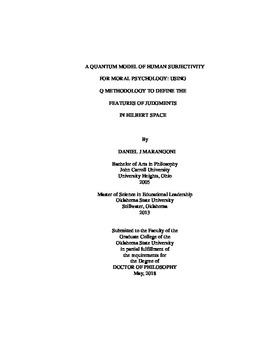| dc.contributor.advisor | Montgomery, Diane | |
| dc.contributor.author | Marangoni, Daniel J. | |
| dc.date.accessioned | 2019-03-25T21:13:39Z | |
| dc.date.available | 2019-03-25T21:13:39Z | |
| dc.date.issued | 2018-05 | |
| dc.identifier.uri | https://hdl.handle.net/11244/317719 | |
| dc.description.abstract | A major issue in the field of moral psychology is identifying aspects of human morality that can be measured. Kantor's (1959) formulation of a psychological event provides a unique option for the field. A psychological event evolves over time through the interaction of current situations and stimuli with historical interbehavioral processes. Kantor's formulation of a psychological event has these elements interacting within the psychological field under review, but the space is undefined. Stephenson (1982) offers Q methodology as a research tool to measure psychological events and does so by defining the psychological field within Hilbert space - generalized Euclidean space where belief states of individuals are represented as vectors within the space. Using the well-known Julie and Mark vignette (Haidt, 2001) about a sister and brother who decide to make love, this study investigates the viewpoints of participants, who are experts in moral philosophy and psychology, regarding the story. In previous studies with the Julie and Mark vignette, participants were unable to articulate their beliefs about the event: this has led to the conclusion that people have intuitive moral reactions, but they often exhibit dumbfounding when they attempt to explain their intuitive reactions (Haidt, 2001). This Q methodology study operationalized the subjective perspectives of participants in order to define their viewpoints. The stable viewpoints are defined with the data and show unique ways of framing the story and are Personal Autonomy, Human Nature, Outcomes, and Individuals in Context. The interpretation of the findings defines these viewpoints and shows how they differ when the vignette is considered from different perspectives. By setting the psychological field within Hilbert space where quantum theory explicitly applies (Stephenson, 1982), the viewpoints can be used to define the features of belief projections as explained by the important work in quantum cognition and decision making. By defining participants' viewpoints, this study shows that people are not dumbfounded about their moral beliefs. | |
| dc.format | application/pdf | |
| dc.language | en_US | |
| dc.rights | Copyright is held by the author who has granted the Oklahoma State University Library the non-exclusive right to share this material in its institutional repository. Contact Digital Library Services at lib-dls@okstate.edu or 405-744-9161 for the permission policy on the use, reproduction or distribution of this material. | |
| dc.title | Quantum model of human subjectivity for moral psychology: Using Q methodology to define the features of judgments in Hilbert space | |
| dc.contributor.committeeMember | May, James | |
| dc.contributor.committeeMember | Grabowski, Francis | |
| dc.contributor.committeeMember | Khojasteh, Jam | |
| dc.contributor.committeeMember | Carlozzi, Al | |
| osu.filename | Marangoni_okstate_0664D_15655.pdf | |
| osu.accesstype | Open Access | |
| dc.type.genre | Dissertation | |
| dc.type.material | Text | |
| thesis.degree.discipline | Educational Psychology | |
| thesis.degree.grantor | Oklahoma State University | |
